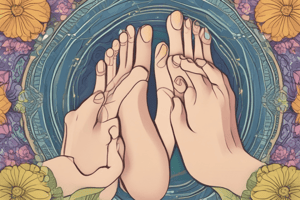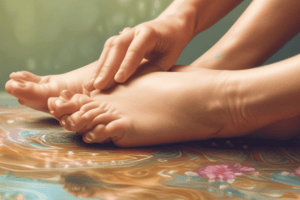Podcast
Questions and Answers
What is the purpose of the four guidelines on the foot in reflexology?
What is the purpose of the four guidelines on the foot in reflexology?
- To locate the diaphragm
- To determine the type of massage
- To identify the reflexes (correct)
- To massage the entire foot
What is one of the applications of reflexology?
What is one of the applications of reflexology?
- Heart surgery
- Cancer treatment
- Low back pain management (correct)
- Organ transplant
Why should reflexology be avoided during the first trimester of pregnancy?
Why should reflexology be avoided during the first trimester of pregnancy?
- It may cause miscarriage
- It may cause stress to the mother
- It may cause fetal damage
- It may cause overstimulation of the body system (correct)
What is a contraindication for reflexology?
What is a contraindication for reflexology?
What should a reflexologist do if a patient continues to have a negative reaction to reflexology?
What should a reflexologist do if a patient continues to have a negative reaction to reflexology?
What is a condition in which reflexology should not be applied to the feet?
What is a condition in which reflexology should not be applied to the feet?
What is one of the potential risks of reflexology when applied to a patient with a localized infection?
What is one of the potential risks of reflexology when applied to a patient with a localized infection?
Why should reflexology be avoided during an infectious disease?
Why should reflexology be avoided during an infectious disease?
What is the title of the research article that discusses the concept and evidence of reflexology?
What is the title of the research article that discusses the concept and evidence of reflexology?
What is one of the conditions in which reflexology may be beneficial?
What is one of the conditions in which reflexology may be beneficial?
Flashcards are hidden until you start studying
Study Notes
Reflexology Overview
- Reflexology is a systematic practice that applies pressure to specific points on the feet and hands to impact related body parts.
- It is based on the idea that each point on the feet and hands corresponds to a specific part of the body.
Reflexology Theory
- Reflexology relies on the reflexes map of the feet and hands to internal organs and body parts.
- Applying pressure to specific points on the feet and hands can energize and rejuvenate other body parts.
- The goal of reflexology is to release blockages, stimulate circulation, and improve nerve and blood supply.
Zone Theory
- Zone theory divides the body into 10 vertical zones, each corresponding to fingers and toes up to the top of the head.
- Every organ, muscle, etc. within a zone can be accessed via a point or area on the feet or hands.
Theories Supporting Reflexology
- Five theories support how reflexology affects body health:
- Energy theory: body parts communicate using electromagnetic fields.
- Energy flow can be restored and blocked pathways opened.
- Reflexology can break up lactic acid crystals in the feet, allowing energy to flow efficiently.
History of Reflexology
- Modern reflexology techniques have been used for over 60 years.
- The earliest discovery of reflexology was found in Egypt (2330 BC) and China (5000 years ago).
- Dr. William Fitzgerald (1872-1942) is considered the father of modern reflexology.
Benefits of Reflexology
- Reduces stress by applying pressure to specific areas, inducing relaxation and relaxation of targeted areas.
- Releases endorphin, the body's natural pain-relieving chemical, to help with pain relief.
- Promotes recovery from injuries and illness.
Guiding Principles of Reflexology
- The body repairs itself, and the reflexologist is a participant in the session.
- Reflexology takes into account all aspects of the client's being: body, emotion, mind, and spirit.
Maps of Reflexology
- Different maps represent the body reflex areas on the palms and feet.
- Guidelines for locating reflexes include the diaphragm line, waistline, heel line, and tendon line.
Applications of Reflexology
- Low back pain management
- Migraine/headache management
- Stroke management
- Stress reduction
- Multiple sclerosis management
- Peripheral neuropathy in diabetes mellitus management
- Asthma management
Contraindications of Reflexology
- Avoid applying reflexology in:
- Pregnancy (first trimester)
- Diarrhea and vomiting
- Localized skin disease at hands, feet, and ears
- Localized inflammation or swelling of hands, feet, and ears
- Fever and infectious diseases
- Continuing extreme negative reaction to reflexology
Studying That Suits You
Use AI to generate personalized quizzes and flashcards to suit your learning preferences.




